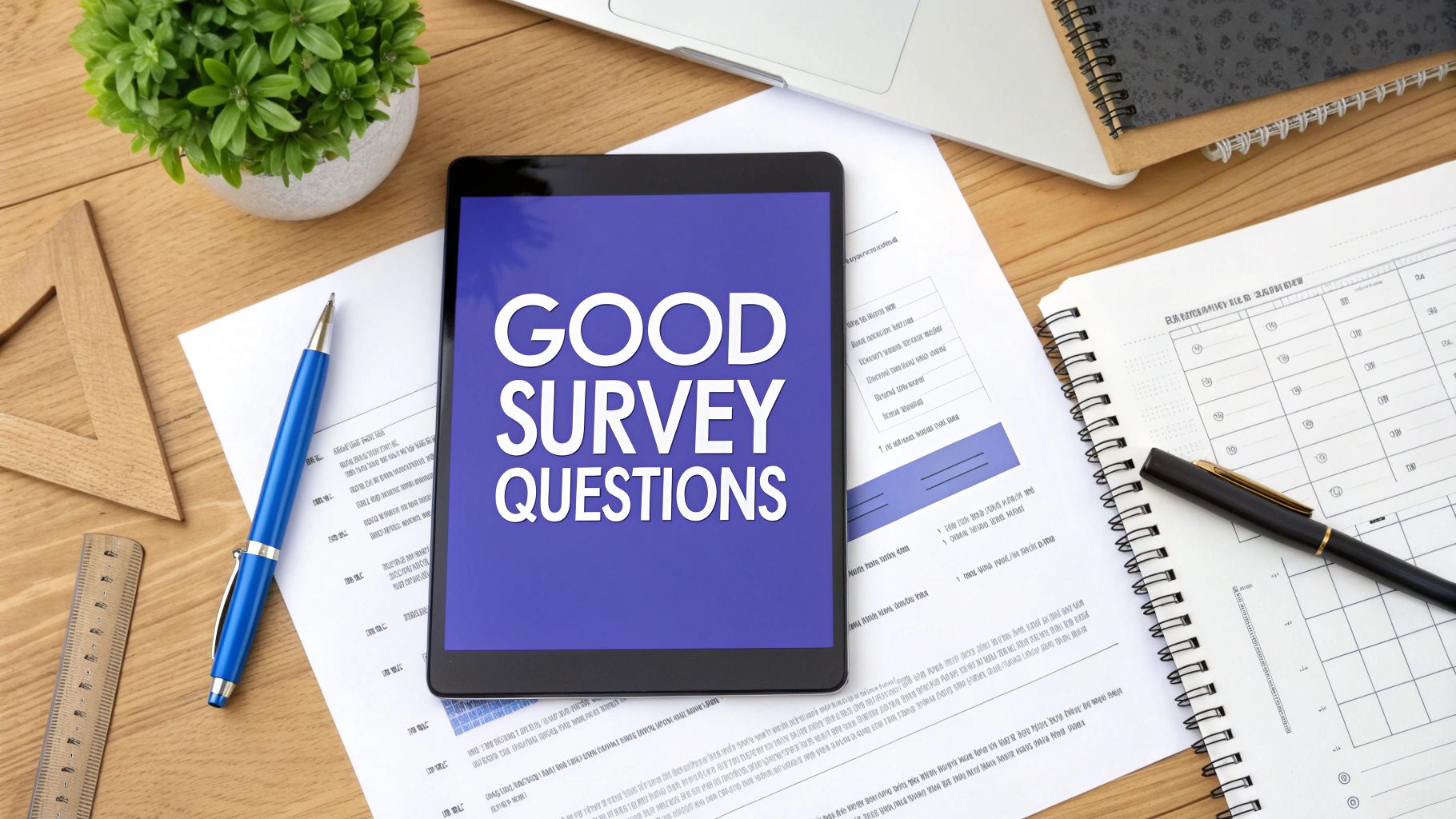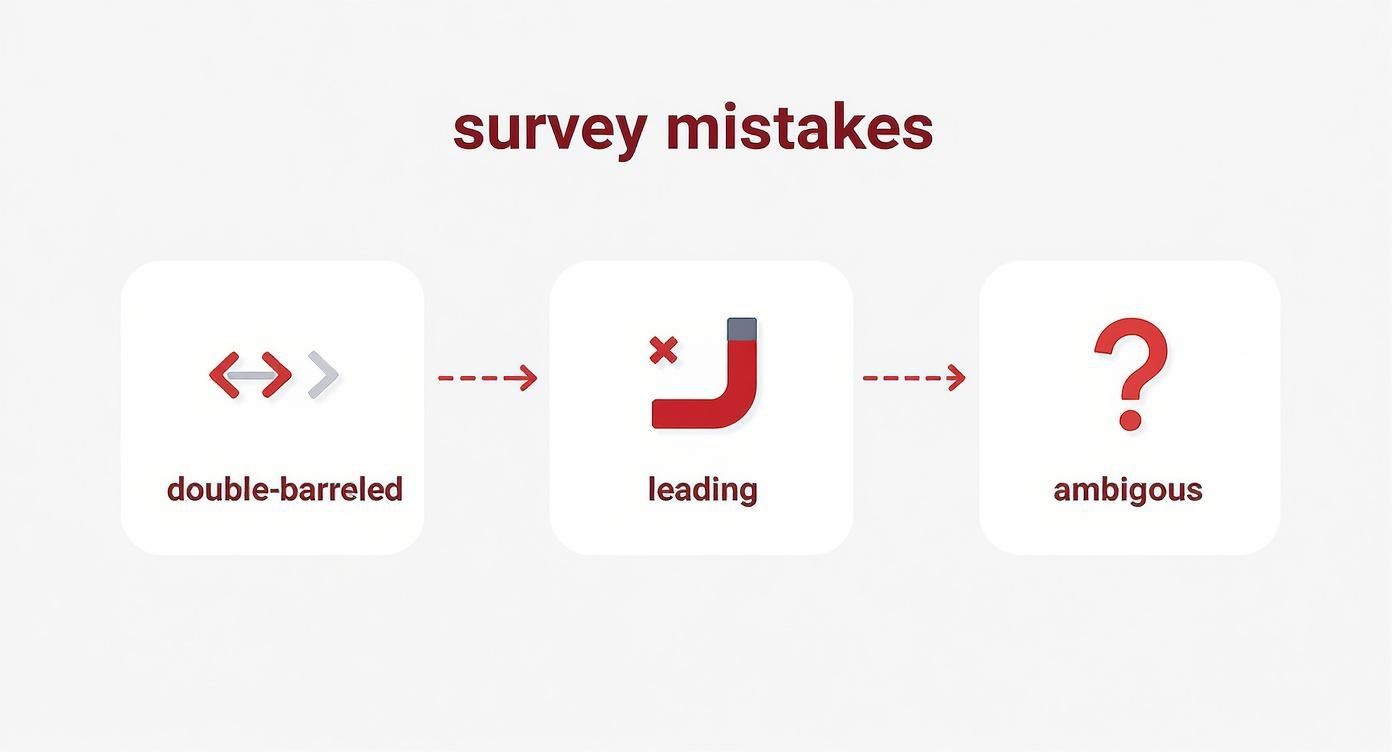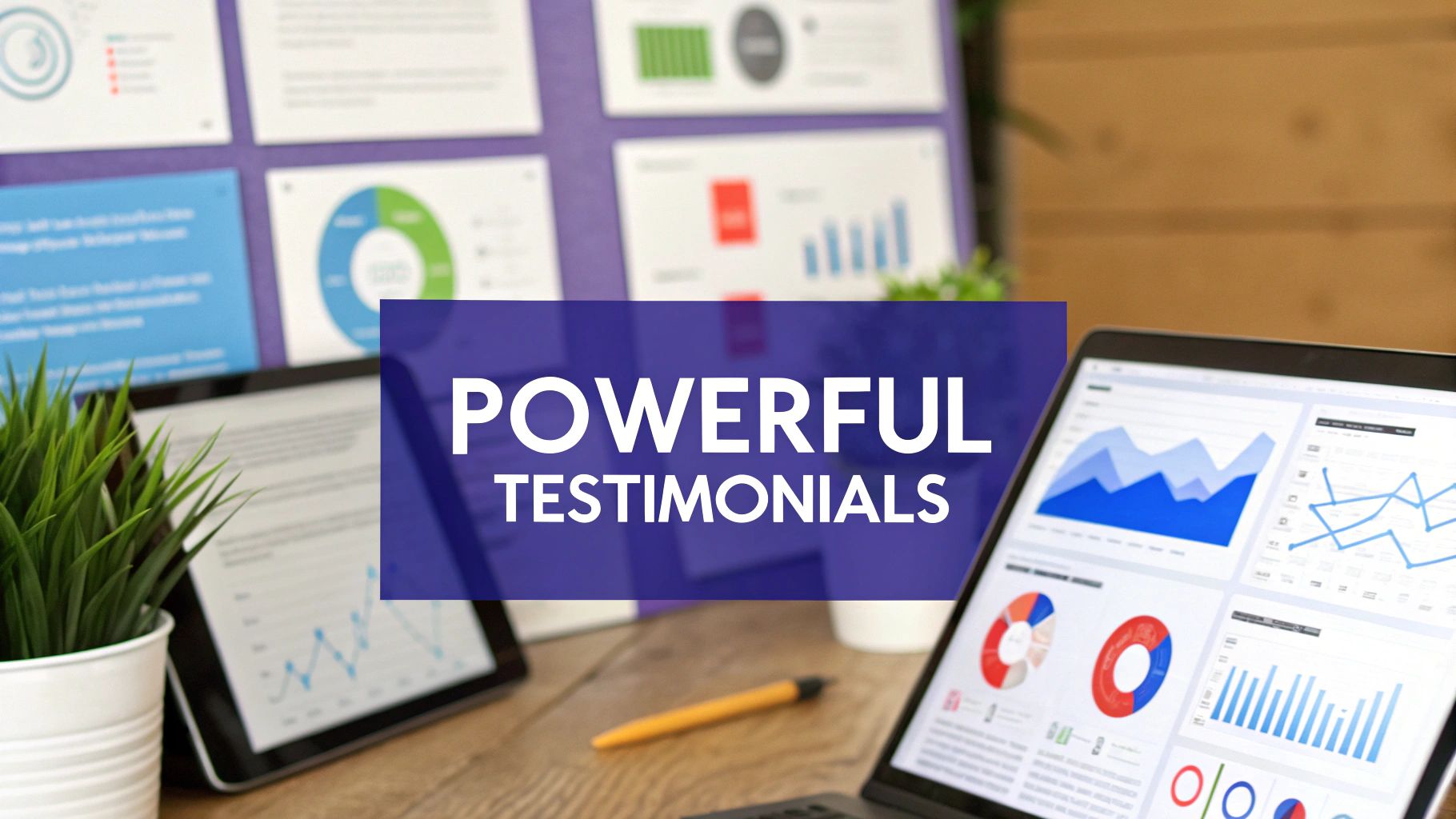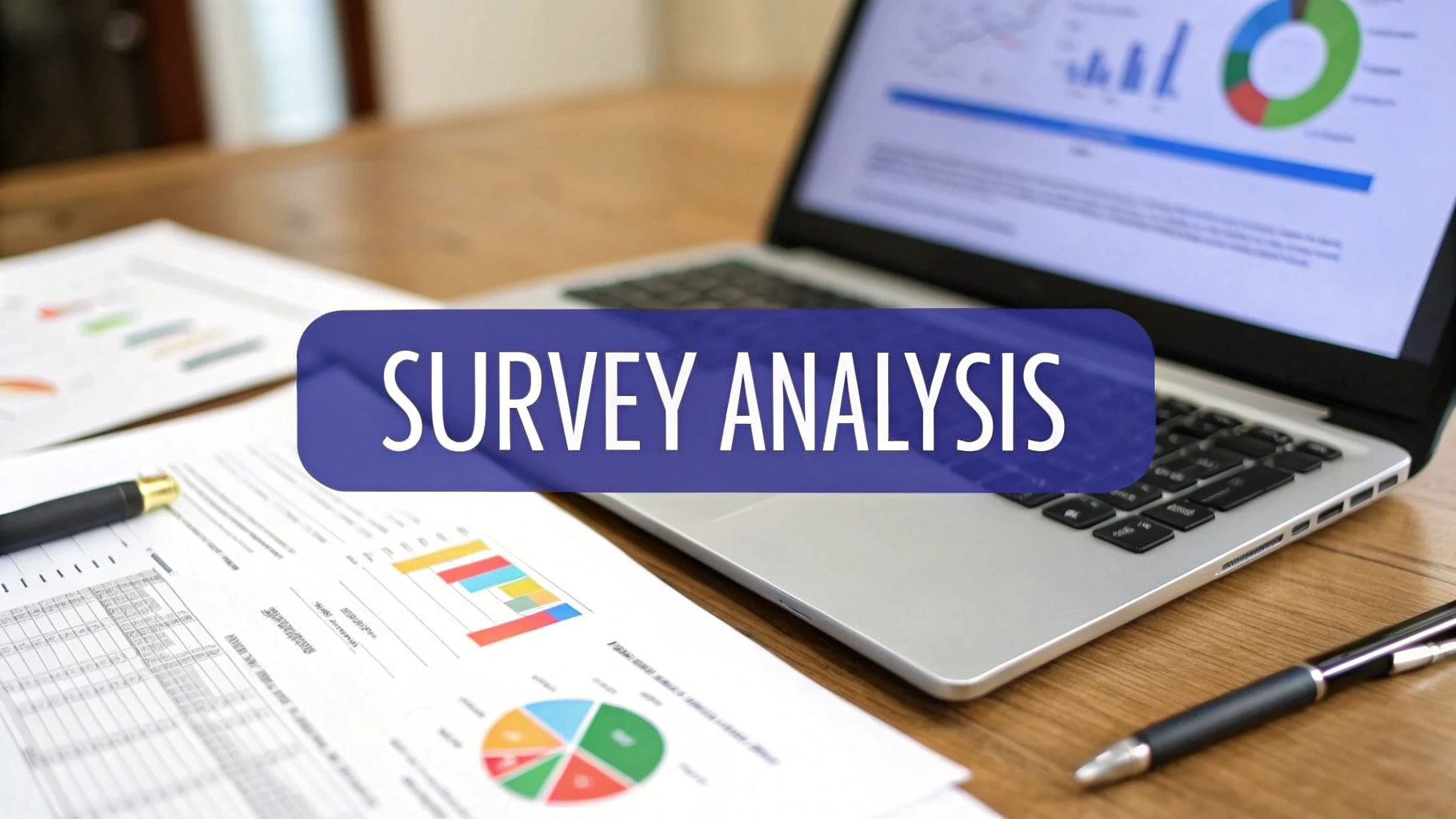What Is a Good Survey Question? A Practical Guide
What is a good survey question? Learn how to write clear, unbiased questions that deliver high-quality data and get the answers you need for your research.

So, what makes a survey question good?
A good survey question is clear, focused, and designed to get you an honest answer without tripping up the person taking it. It should tackle a single idea using simple language that anyone can understand. It really is that straightforward.
The quality of your data depends entirely on the quality of your questions.
Think of it this way: if your questions are confusing, you’ll get confusing data. Garbage in, garbage out.
The Anatomy of a Great Survey Question

Imagine a survey question is a tool built for a specific job. If that tool is clunky or poorly made, you are not going to get the result you want. A great question carves a direct path to reliable information, making sure the insights you gather are trustworthy and actually useful.
But if your questions are vague, biased, or try to ask two things at once (we call those "double-barreled" questions), you’ll end up with a pile of muddled data that can’t steer your decisions.
The real goal is to remove any and all guesswork for the respondent. They should know exactly what you are asking the second they read it and feel comfortable giving a straight answer.
To help you get a clearer picture, let's break down the basic elements.
Table: Key Characteristics of a Good Survey Question
Here is a quick look at the core attributes that define an effective survey question. Keep these in mind as you start writing your own.
Getting these four characteristics right is the foundation for building any effective survey.
Why Question Quality Is a Big Deal
Here’s the thing: poorly written questions can wreck your research.
When your participants run into confusing or difficult questions, they might just give up and abandon the survey. Or even worse, they'll start clicking random answers just to get it over with. This phenomenon is known as survey fatigue, and it’s a data killer.
A well-designed question is your first line of defense against bad data. It respects the respondent's time and intelligence, which encourages more thoughtful and accurate participation.
For example, research consistently shows that well-designed questions dramatically improve response accuracy. Even something as simple as strategic question sequencing, like starting with easier questions to build momentum, helps keep people engaged. You can learn more about these effective survey design strategies on vbpd.virginia.gov.
Ultimately, putting in the time to craft clear, simple, and unbiased questions always pays off. It leads to higher completion rates and, most importantly, gives you clean data that reflects what your users truly think. For any SaaS team, this is the foundation for making confident, data-driven decisions about your product, marketing, and customer experience.
Core Principles for Writing Effective Questions
Knowing what a good survey question looks like is the first step. The next is learning how to write one yourself. To get clear, honest data, you need to stick to a few fundamental principles. These are your guideposts, making sure every single question you craft is built to succeed.
Think of these principles as the recipe for a perfect question. Miss an ingredient, and the final result just will not be right. Following them helps you dodge common pitfalls and makes sure the data you collect is both accurate and genuinely useful.
Use Simple and Clear Language
The most important rule? Keep it simple. Your questions should be so easy to read that anyone can understand them without a second thought. That means cutting out the jargon, technical terms, or complex phrasing that might trip up your audience. The goal is to make answering feel effortless.
- Before: "What are your perceptions regarding the efficacy of our onboarding sequence?"
- After: "How helpful was our onboarding process?"
The second version is direct and uses everyday language. This small tweak makes a huge difference in how easily people can respond, which is exactly what you want.
A question is only as good as its simplest interpretation. If there is any room for misunderstanding, you'll get mixed results.
Be Specific and Focused
Vague questions lead to vague answers. Simple as that. Each question should zero in on one specific idea. When you are not specific enough, respondents are forced to guess what you mean, which contaminates your data.
For example, asking "Do you like our app?" is way too broad. "Like" could mean anything from the design to the features to the loading speed. A more specific question gets you much better information.
- Before: "What do you think of our product?"
- After: "On a scale of 1-5, how would you rate the speed of our app?"
The revised question pinpoints exactly what you want to measure. This level of focus is what separates a generic question from a professionally crafted one.
Stay Neutral and Unbiased
Your questions have to be neutral. You cannot word them in a way that hints at a "correct" answer or reveals your own opinion. This is called a leading question, and it’s one of the fastest ways to get biased, unreliable feedback.
Leading questions often contain positive or negative assumptions that gently nudge people in a certain direction. Your job is to present the question objectively, giving the respondent the freedom to form their own opinion without any influence from you.
- Before: "How much did you enjoy our amazing new feature?"
- After: "How would you rate your experience with our new feature?"
The second question removes the biased word "amazing" and lets the user give their honest feedback, whether it’s good or bad. For more detailed guidance, check out our complete guide on how to write survey questions that deliver unbiased insights.
Mastering these principles will help you create surveys that people actually finish, and that give you data you can truly trust.
Common Mistakes in Survey Question Design
Knowing what to avoid is often just as important as knowing what to do. It only takes one poorly worded question to throw off your entire survey, introducing bias that makes your data unreliable. If you can steer clear of a few common pitfalls, you’re already well on your way to collecting clean, honest feedback.
Most of these mistakes are unintentional, but they can still completely undermine your results. Let's walk through the usual suspects and how to fix them so you can protect your survey's integrity from the get-go.
Double-Barreled Questions
A double-barreled question is a classic mistake where you cram two different topics into a single question. This forces people to give one answer for two separate issues, which is pretty much impossible to do accurately. The data you get back is a mess because you'll have no idea which part of the question they were actually answering.
- Bad Example: "How satisfied are you with our product's performance and design?"
- Good Example: "How satisfied are you with our product's performance?" and "How satisfied are you with our product's design?"
Splitting them into two distinct questions is a simple fix that gives you a much clearer, more actionable answer for each topic.
Leading and Loaded Questions
Leading and loaded questions are another major red flag. A leading question subtly nudges someone toward a certain answer by using biased phrasing. A loaded question, on the other hand, contains an assumption about the respondent that might not be true. Both can seriously skew the answers you get.
- Leading Example (Bad): "How much did you enjoy our award-winning customer support?"
- Neutral Example (Good): "How would you rate your experience with our customer support?"
That little phrase "award-winning" implies the support is amazing, which can pressure people into giving a more positive rating than they might have otherwise. You can dive deeper into how tiny wording changes can create big problems in our guide to recognizing and avoiding biased survey questions.
Ambiguous Questions
Ambiguous questions are just plain unclear. They use vague words like "often," "regularly," or "sometimes" that mean different things to different people. When your language is fuzzy, you cannot be sure what your respondents are actually telling you.
- Bad Example: "Do you use our new feature regularly?"
- Good Example: "How many times did you use our new feature in the last week?"
The better version swaps the vague word "regularly" for a concrete timeframe, making sure every response is measured by the same yardstick. This is a common theme in survey design, specificity is your friend. As the usability experts at the Nielsen Norman Group point out, using unbalanced scales or asking people to predict the future are other common ways ambiguity can creep in and muddy your data.
Choosing the Right Type of Survey Question
Not all questions are created equal. Different goals demand different tools, and the same is true for surveys. You would not use a hammer to turn a screw, right? In the same way, you cannot expect a multiple-choice question to give you the rich, personal stories that an open-ended one can.
Picking the right format is where your survey strategy gets serious. It's the difference between just asking questions and asking the right questions in the right way. The structure you choose directly shapes the data you get back. Some are built for quick, quantifiable stats, while others are designed to capture thoughtful, qualitative feedback.
Open-Ended Questions for Deep Insights
When you want to explore a topic without boxing people in, open-ended questions are your go-to. They’re essentially blank text boxes where people can share their thoughts in their own words, giving you detailed, nuanced feedback you might never have thought to ask about.
Think of it as starting a real conversation. Instead of feeding them options, you’re inviting them to tell you a story.
- When to use them: Perfect for digging into the "why" behind user behavior, gathering specific examples, or collecting authentic testimonials.
- Example: "What's the one thing we could do to make your experience with our app even better?"
The trade-off? Analyzing all that qualitative data takes more work than glancing at a pie chart. But the depth of insight you can uncover is almost always worth the extra effort.
Multiple-Choice Questions for Easy Analysis
Multiple-choice questions are the reliable workhorses of the survey world. They give respondents a pre-set list of answers, which makes the data a breeze to collect and analyze. This format is ideal for gathering quantitative data you can quickly turn into clean charts and graphs.
These are fantastic for segmenting your audience or measuring preferences, especially when you already have a good sense of the likely answers.
- When to use them: Use them for demographic questions (like role or industry), tracking feature adoption, or anytime you need clear-cut, countable data.
- Example: "Which of our new features have you tried in the last 30 days? (Select all that apply)"
The trick is making sure your answer options cover all the bases and do not overlap. When in doubt, adding an "Other (please specify)" option is a great safety net. For a deeper look into the various formats, our guide on the primary types of survey questions is a great place to start.
No matter which format you pick, it's important to avoid common pitfalls like double-barreled or leading questions, which can skew your results. The infographic below shows just how easy it is to accidentally introduce bias.

This visual is a great reminder to keep every question laser-focused on a single idea.
Rating Scales to Measure Opinions
Rating scales, like Likert scales or star ratings, are perfect for measuring attitudes, opinions, and satisfaction levels. They ask people to place their feelings on a numerical scale, typically from 1 to 5 or 1 to 10, turning subjective feelings into quantifiable data.
- When to use them: Helpful for measuring customer satisfaction (CSAT), gauging agreement with a statement, or assessing the perceived quality of a feature.
- Example: "On a scale of 1 to 5, how satisfied were you with our customer support today?"
These scales strike a fantastic balance. They give you hard numbers you can track over time, but they still manage to capture a degree of human feeling.
Picking the right question type is half the battle. To make it even clearer, here’s a quick breakdown to help you decide which format best fits your needs.
Choosing the Right Question Type
Ultimately, the best surveys often use a mix of these question types, balancing the ease of quantitative data with the depth of qualitative feedback.
How to Structure and Test Your Survey
A great survey is more than just a list of questions; it is a well-thought-out conversation. The way you arrange your questions can make or break the entire experience, directly impacting how many people finish it and the quality of the data you get back.
Think of your survey's structure like a story. It needs a clear beginning, middle, and end. You want to ease people in with simple, engaging questions before you dive into the more complex or sensitive stuff.
Creating a Logical Survey Flow
When a survey is organized well, it just feels right. A simple way to start is by grouping related questions together. For example, keep all the questions about a specific feature in one block instead of sprinkling them throughout. This helps people stay focused and gives their answers better context.
Another powerful technique is using skip logic, sometimes called conditional logic. This creates a custom path for each person, so they only see questions that are relevant to them. If someone says they’ve never used a certain feature, you can automatically skip all the follow-up questions about it.
A survey without a logical flow is like a conversation that keeps jumping between random topics. It's confusing, frustrating, and most people will just walk away.
Modern survey tools are built to help with this. Getting familiar with screenask features for survey construction, for instance, can give you a better feel for what’s possible with question types and flow. Good structure shows you respect the respondent's time and makes the whole process feel more professional.
The Importance of Pilot Testing
No matter how confident you are in your survey design, you should never launch it without a test run. A pilot test is where you send your survey to a small, representative group of people before it goes out to your main audience. This is your chance to find and fix any problems while the stakes are still low.
This step is your safety net for catching issues you might have overlooked:
- Confusing Questions: Do your testers actually get what you are asking?
- Technical Glitches: Does the skip logic work properly on every device?
- Formatting Problems: Is the layout a mess on a mobile phone?
- Survey Length: How long does it really take to complete?
According to the Pew Research Center, survey design is a multi-step process for a reason. Their research shows that up to 25% of questions in new surveys need to be tweaked after pilot testing to avoid being misinterpreted. A quick test run can save you from the disaster of collecting a mountain of bad data.
A Few Common Survey Design Questions, Answered
Even when you know the principles, a few practical questions always seem to pop up in the middle of building a survey. Let's tackle some of the most common ones that teams run into.
How Many Questions Should My Survey Have?
There is no magic number, but shorter is almost always better. A good rule of thumb is to aim for a survey people can complete in 5 to 7 minutes. That usually lands you somewhere around 10 to 12 questions.
Long surveys are the number one killer of completion rates. People get tired, bored, or just plain annoyed, and they'll either bail or start giving lazy, rushed answers to get it over with. Before adding any question, ask yourself: is this data a "must-have" or just a "nice-to-have"? If it is not absolutely needed, leave it out. You'll respect your audience's time and get much cleaner, more focused data.
What’s the Difference Between a Leading and a Loaded Question?
Both are sneaky forms of bias that can wreck your data, but they work in slightly different ways. Knowing how to spot each one is key to writing neutral, effective questions.
A leading question subtly nudges the respondent toward a specific answer. The phrasing itself does the persuading.
- Example: "How satisfied were you with our excellent customer service?"
A loaded question, on the other hand, contains a hidden assumption the respondent might not agree with. Answering it forces them to accept a premise that may be false.
- Example: "Where do you typically go for your morning coffee?"
The second example assumes the person even drinks coffee in the morning. To fix these, you have to strip out the bias. A neutral approach would be, "How would you rate our customer service?" and "Do you drink coffee in the morning?"
Should I Make Every Survey Question Mandatory?
Definitely not. Forcing people to answer every single question is a surefire way to frustrate them. When faced with a required question they cannot or do not want to answer, they'll do one of two things: abandon the survey entirely or, even worse, punch in fake information just to move on. That leaves you with messy, unreliable data.
A much better approach is to only require the absolute must-haves. A great example is a "screener" question at the very beginning to confirm someone is actually in your target audience. For everything else, give people an out. Including a "Not applicable" or "Prefer not to answer" option keeps them in control and leads to more honest, high-quality data.
How Important Is Making a Survey Mobile-Friendly?
It’s absolutely critical. There’s a very good chance a huge chunk of your audience will be taking your survey on a smartphone. If the questions are hard to read or the buttons are too tiny to tap, you are going to lose a lot of people before they even finish.
You should really design with a "mobile-first" mindset. This means:
- Using simple, single-column layouts.
- Sticking to single-choice questions instead of complex grids.
- Making sure buttons and answer fields are big enough for easy tapping.
This creates a smooth experience for everyone, no matter what device they are on, which is a simple way to boost your completion rates.
Ready to turn feedback into growth? Surva.ai gives SaaS teams the tools to build smarter surveys, reduce churn, and get to know users on a deeper level. Start creating effective surveys today.


